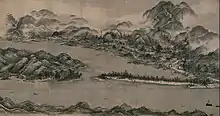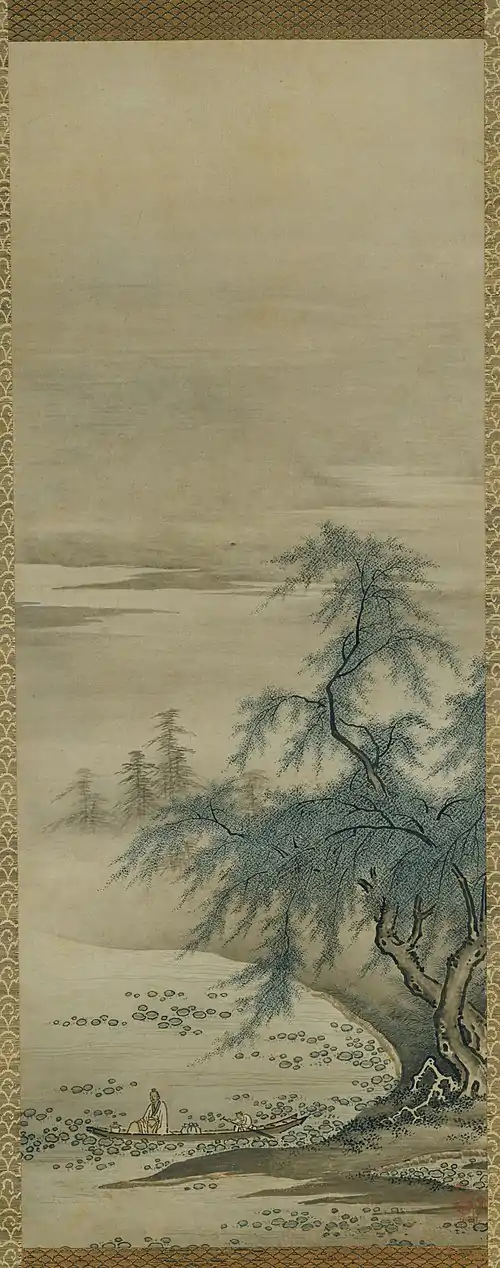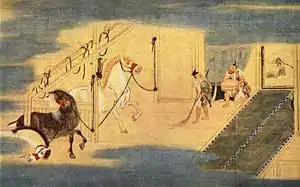
The Higashiyama culture (東山文化 Higashiyama bunka) is a segment of Japanese culture that includes innovations in architecture, the visual arts and theatre during the late Muromachi period. It originated and was promoted in the 15th century by the shōgun Ashikaga Yoshimasa, after he retired to his villa in the eastern hills (東山 Higashiyama) of capital city Kyoto.
History

The Ashikaga Shogunate of the 14th century renewed diplomatic relations with Ming Dynasty China under Yoshinori, in an overtly vassal relationship. Through access to Chinese culture, the Shogunate imported the latest cultural trends through the Shogun Yoshimasa but with a distinctly Japanese aesthetic. This is what became known as the "Higashiyama Culture" due to the centrality of Yoshimasa's influence, and named after the district in Kyoto where he built his retreat. Yoshimasa did not single-handedly contribute to the aesthetic, but recruited artistic talents, sponsoring them, and provided valuable critique.[1]
Based largely on the ideals and aesthetics of Zen Buddhism, especially those temples under the Five Mountain System, and the concept of wabi-sabi, Higashiyama culture centered on the development of chadō (Japanese tea ceremony), ikebana (flower arranging), Noh drama, and sumi-e ink painting. Much of what is commonly seen today as Japanese Zen aesthetics originated in this period. Higashiyama culture is often contrasted with Kitayama bunka (北山文化), the "Kitayama Culture" came earlier in the Muromachi period. In this comparison Kinkaku-ji, representative of Kitayama culture is compared with Ginkaku-ji, representative of Higashiyama culture.[2]
Yoshimasa's retirement villa was turned into the temple Ginkaku-ji (the Temple of the Silver Pavilion) after his death. It is situated in Kyoto's Sakyō-ku, and was the center of the Higashiyama cultural outgrowth and known for its Zen and wabi-sabi aesthetics. The retired shogun invited many artists, poets, and court nobles to his villa, encouraging the development of their arts. A vast and priceless collection of artifacts came together, which was known as the Higashiyama Treasure.[3]
Noteworthy Figures
Among the figures who influenced the Higashiyama culture are the following:
- Sesshū Tōyō - a Zen-Buddhist monk and painter
- Kanō Masanobu - founder of the Kanō school of painting.
- Oguri Sōtan - a painter of Japan's Kanō school
- Ryūami - a master of flower-arrangement.
- Senkei - a member of the Ikenobō school of flower-arrangement.
- Sen no Rikyū - a master of the Japanese tea ceremony.
- Zeami Motokiyo - a master playwright of Noh theater.
- Sōgi - a master of renga poetry
- Shinkei - another master of renga poetry
Examples
The Tōgu-Dō building structure includes a shoin-style room called the Dōjinsai. It originally had a fireplace built into the floor, and due to this, the Dōjinsai is considered the earliest extant example of a room designed for use as a tea room.[4]
There were many architectural innovations in this period, exhibited in the Ginkaku-ji in particular, which would later become core elements in the shoin style of 17th century architecture. One of these elements was the tokonoma, a small alcove in which scrolls are hung, and flowers or other small articles are placed to enhance the aesthetic feel of the room. The great ink-painter Sesshū Tōyō spent much time at the Ginkaku-ji, and this period also saw the birth of the Kanō school of Japanese painting as well as an early version of the chanoyu tea ceremony. Tea ceremonies would be further formalized by Sen no Rikyū in the 16th century.[5]
Important dates

Notable dates within this period include:
- February 21, 1482 (Bummei 14 , 4th day of the 2nd month): Construction of the Silver Pavilion commenced.
- January 27, 1490 (Entoku 2, 7th day of the 1st month): The former-Shogun Yoshimasa died at age 56 in his Higashiyama-dono estate,[6] which marked the beginning of the end of Higashiyama bunka.
Examples
Examples of Higashiyama culture include:
Architecture
- Ginkaku and Garden of Jishō-ji
- Karesansui of Ryōan-ji
- Karesansui of Daisen-in
Calligraphy and painting
- View of Ama-no-Hashidate by Sesshū (Kyoto National Museum)
- Zhou Maoshu Appreciating Lotuses, a hanging scroll by Kanō Masanobu (Kyūshū National Museum)
- Seikōji engi emaki by Tosa Mitsunobu (Tokyo National Museum)
 "View of Ama-no-Hashidate" by Sesshū
"View of Ama-no-Hashidate" by Sesshū "Zhou Maoshu Appreciating Lotuses", a hanging scroll by Kanō Masanobu
"Zhou Maoshu Appreciating Lotuses", a hanging scroll by Kanō Masanobu "Seikōji engi emaki" by Tosa Mitsunobu
"Seikōji engi emaki" by Tosa Mitsunobu
See also
Notes
- ↑ Keene, Donald (2003). Yoshimasa and the Silver Pavilion: The Creation of the Soul of Japan. Columbia University Press; First Edition. p. 71-72,78-79. ISBN 9780231130561.
- ↑ "JAANUS / Higashiyama bunka 東山文化". www.aisf.or.jp. Retrieved 2023-12-10.
- ↑ "A brief history of the arts of Japan: the Kamakura to Azuchi-Momoyama periods (article)". Khan Academy. Retrieved 2023-12-10.
- ↑ Yasuhiko Murai, tr. Alfred Birnbaum, "A Brief History of Tea in Japan." Chapter One in CHANOYU: The Urasenke Tradition of Tea. Weatherhill, 1988.
- ↑ "A Theory of Culture during the Ōei and Eikyō periods: Between Popular Views of History on "Kitayama Culture" and "Higashiyama Culture" | Team Research 2018". www.nichibun.ac.jp. Retrieved 2023-12-10.
- ↑ Titsingh, p. 361.
References
- "Higashiyama Bunka", JAANUS: Japanese Architecture and Art Net Users System.
- Keene, Donald. (2003). Yoshimasa and the Silver Pavilion: The Creation of the Soul of Japan. New York: Columbia University Press. ISBN 978-0-231-13056-1; OCLC 52268947
- Titsingh, Isaac, ed. (1834), [Siyun-sai Rin-siyo/Hayashi Gahō, 1652], Nipon o daï itsi ran; ou, Annales des empereurs du Japon. Paris: Oriental Translation Fund of Great Britain and Ireland.
- Sansom, George Bailey. (1943). "Japan: A Short Cultural History". New York: Appleton Century Crofts, Inc.
- Steiner, Evgeny. (2014). Zen-Life: Ikkyu and Beyond. Cambridge Scholars Publishing. ISBN 978-1-4438-5400-9.
